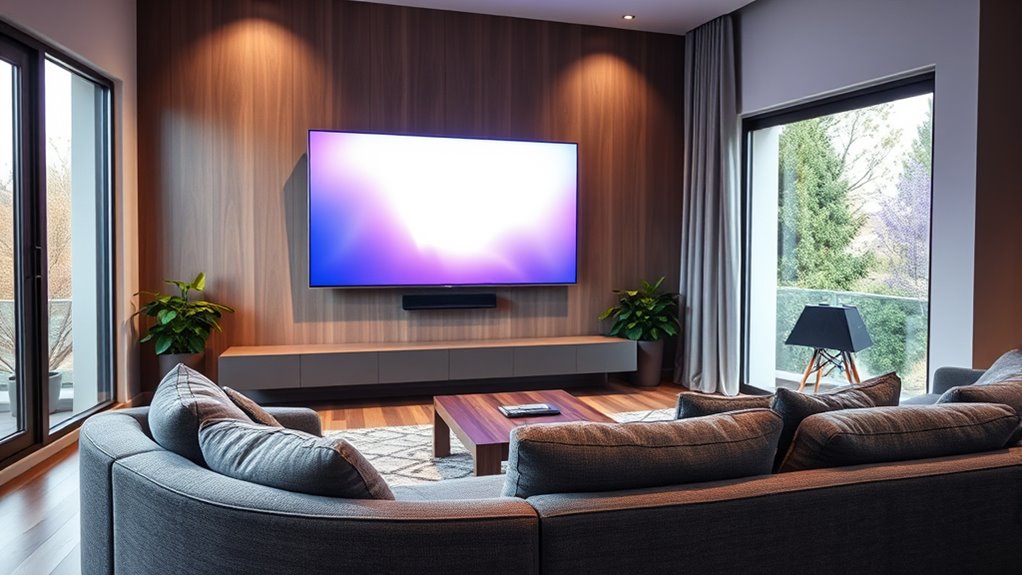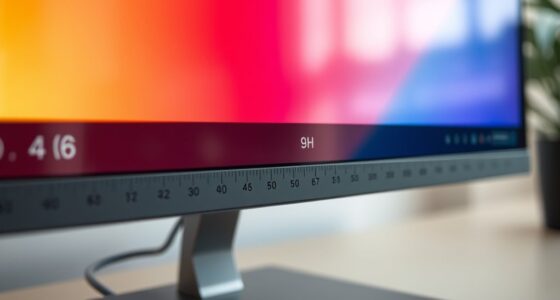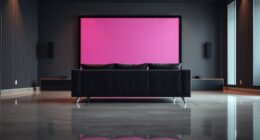Choosing the right screen size and seating distance isn’t about always opting for the biggest screen. Comfort, your visual acuity, and room layout matter more than size alone. A larger screen isn’t better if it causes eye strain or makes it hard to see the whole display. Proper positioning and understanding your space can improve your viewing experience. To discover how to optimize your setup based on these factors, keep exploring what truly makes your viewing comfortable and enjoyable.
Key Takeaways
- Larger screens do not always mean better; they can cause eye strain if oversized for your seating distance.
- Matching screen size to your seating distance enhances comfort and reduces visual fatigue.
- Personal eyesight and room layout influence the optimal viewing distance and screen size choice.
- Proper calibration and understanding of projector or display capabilities are essential for a comfortable setup.
- The ideal setup balances space, personal preferences, and ergonomic considerations rather than just maximizing screen size.
The Myth of “Bigger Is Better”: Why Size Isn’t Everything
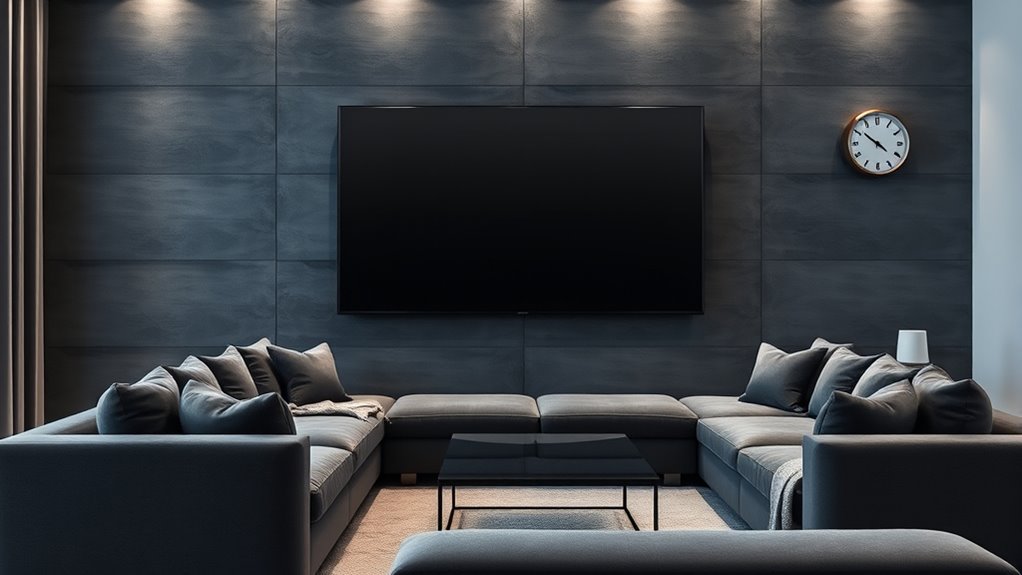
Many people assume that a larger screen automatically provides a better viewing experience, but that’s not always the case. While a bigger screen can seem impressive, it doesn’t guarantee comfort or ideal viewing. Your screen size matters less if your seating isn’t comfortable or if you’re forced to sit too close or too far away. An oversized screen might cause eye strain or make it hard to see the entire display comfortably. Conversely, a screen that’s too small can force you to strain your neck or squint to see details. The key is balancing screen size with your seating comfort. Proper calibration and understanding of your projector’s capabilities are essential for achieving the best image quality and viewing experience. A well-chosen size, paired with proper seating, creates a more enjoyable, immersive experience without unnecessary discomfort. Bigger isn’t always better; it’s about the right fit for your space and comfort.
Understanding the Ideal Viewing Angle and Its Impact on Comfort
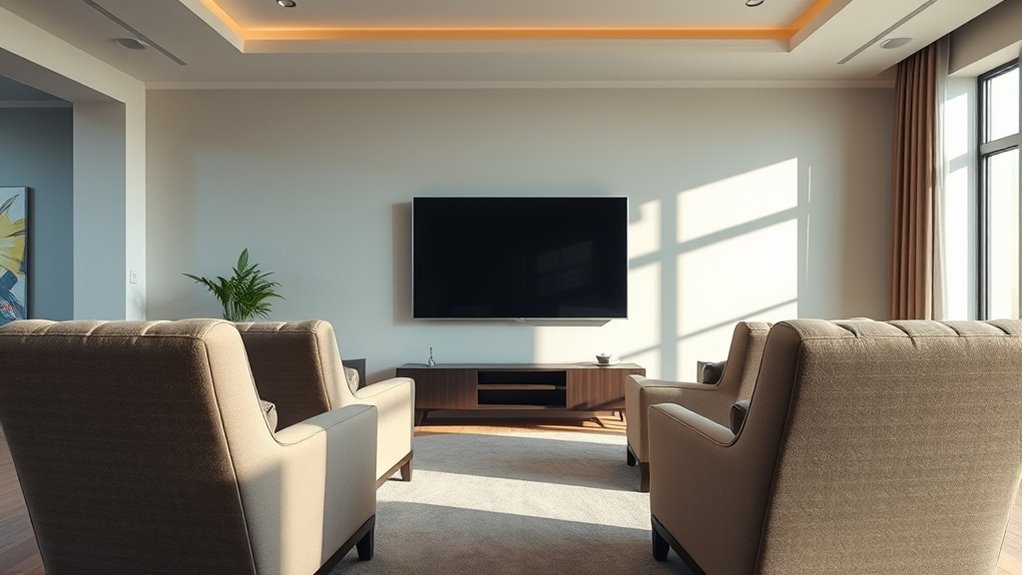
The perfect viewing angle directly influences your comfort and the quality of your viewing experience. Maintaining proper ergonomic positioning reduces strain and enhances visual ergonomics. To achieve this, consider these key points:
- Keep your eyes level with the top third of the screen to avoid neck and eye strain.
- Maintain a viewing angle between 10° to 20° downward from your eye level for ideal comfort.
- Position your screen at a distance where you can see details without leaning forward or squinting.
- Incorporate healthy eating choices into your routine, as proper nutrition supports overall well-being, including ergonomic health.
Visual Acuity and How It Affects Your Seating Choices
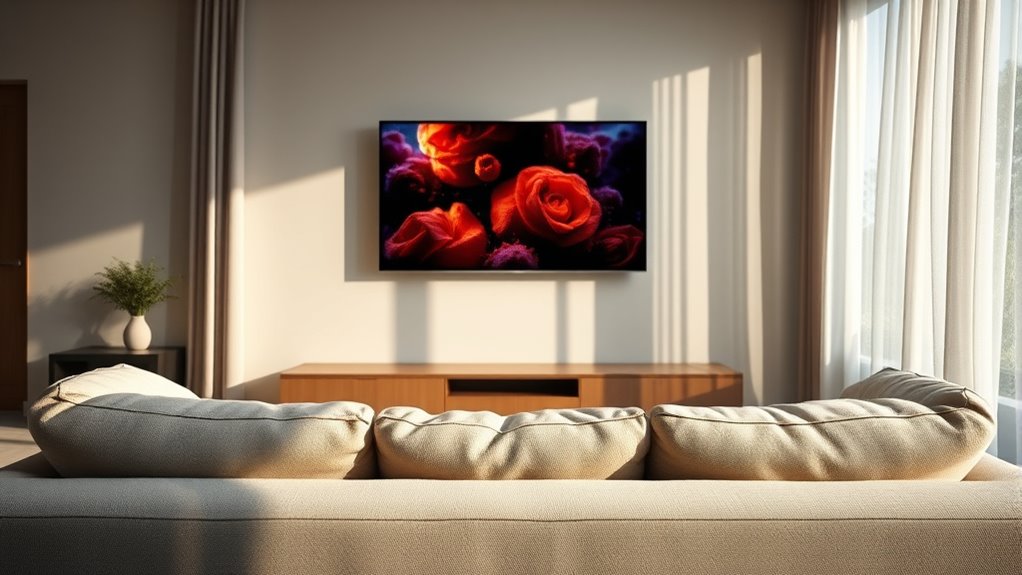
Your visual acuity substantially influences how close or far you should sit from your screen. If your eyesight is sharp, you may comfortably sit farther away, reducing eye strain. Conversely, if you have poorer vision, sitting closer helps you see details clearly, but it can increase eye strain if your screen isn’t optimized. Enhancing color contrast improves clarity and reduces eye fatigue, especially for those with lower acuity. Use this table to assess your needs:
| Visual Acuity Level | Recommended Distance | Key Consideration |
|---|---|---|
| Excellent | Further away | Maximize comfort, reduce eye strain |
| Average | Moderate distance | Adjust for optimal contrast |
| Poor | Closer proximity | Ensure good lighting and contrast |
Tailoring your seating based on visual acuity helps prevent eye strain and enhances viewing comfort. Additionally, understanding how performance tuning principles can optimize your display settings ensures better image quality and reduced fatigue during long viewing sessions.
The Role of Screen Resolution and Image Quality in Viewing Distance
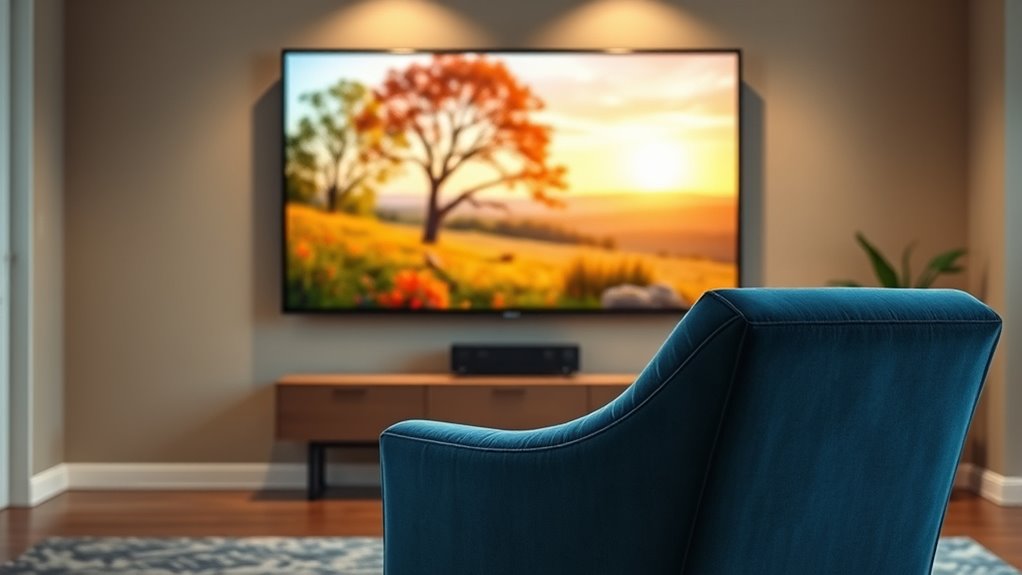
Your viewing experience depends heavily on screen resolution and image quality. Higher resolution means clearer images, so you can sit closer without losing detail. But keep in mind, image compression can affect clarity, especially on larger screens. Additionally, AI-powered image enhancement can improve picture quality, making closer viewing more enjoyable.
Resolution Impact on Clarity
As screen resolution directly influences image clarity, choosing a higher resolution can significantly enhance your viewing experience, especially at closer distances. Higher resolution displays reveal more detailed images, making scenes sharper and more immersive. To maximize clarity, pay attention to these factors:
- Color calibration: Proper calibration ensures colors appear vibrant and true-to-life, enhancing visual detail.
- Pixel density: Higher pixel counts reduce pixelation, especially when sitting close, delivering crisper images.
- Sound quality: While not directly related to resolution, good sound complements sharp visuals, creating a more engaging experience.
- Display type: Different screen technologies can also impact how resolution affects image quality and viewing comfort.
Image Compression Effects
Image compression plays a crucial role in how screen resolution impacts your viewing experience, especially at varying distances. When images are compressed, they often undergo pixel degradation, which can reduce detail and sharpness. This process strips away unnecessary data to make files smaller, but it can also introduce artifacts and blur, making images appear less clear. At closer viewing distances, compressed images might seem noticeably less crisp, as your eyes pick up pixelation or distortion. Conversely, at farther distances, the effects of compression are less apparent, and the overall image quality may still seem acceptable. Understanding how image compression influences pixel degradation helps you choose screens and settings that maintain quality, regardless of seating distance. Additionally, proper compression settings can help preserve image clarity across different viewing scenarios.
Screen Size vs. Detail
The relationship between screen size and image detail becomes especially important as you consider different viewing distances. Larger screens demand higher resolution to maintain crispness and avoid pixelation, impacting screen aesthetics and overall image quality. When sitting closer, you notice finer details, making resolution vital for immersive viewing. To optimize your experience, keep these points in mind:
- Higher resolutions (like 4K or 8K) enhance detail on bigger screens, especially at closer distances.
- Ambient lighting influences perceived image quality, so controlling glare helps your eyes focus on detail.
- Smaller screens can get away with lower resolution without sacrificing clarity, but larger screens need sharper images to prevent blurriness.
- Regular eye care, including the use of eye patches, can help reduce strain and maintain visual comfort during extended viewing sessions.
Understanding these factors ensures your setup balances screen size, resolution, and ambient lighting for the best visual experience.
Personal Preferences and Viewing Habits: Customizing Your Setup
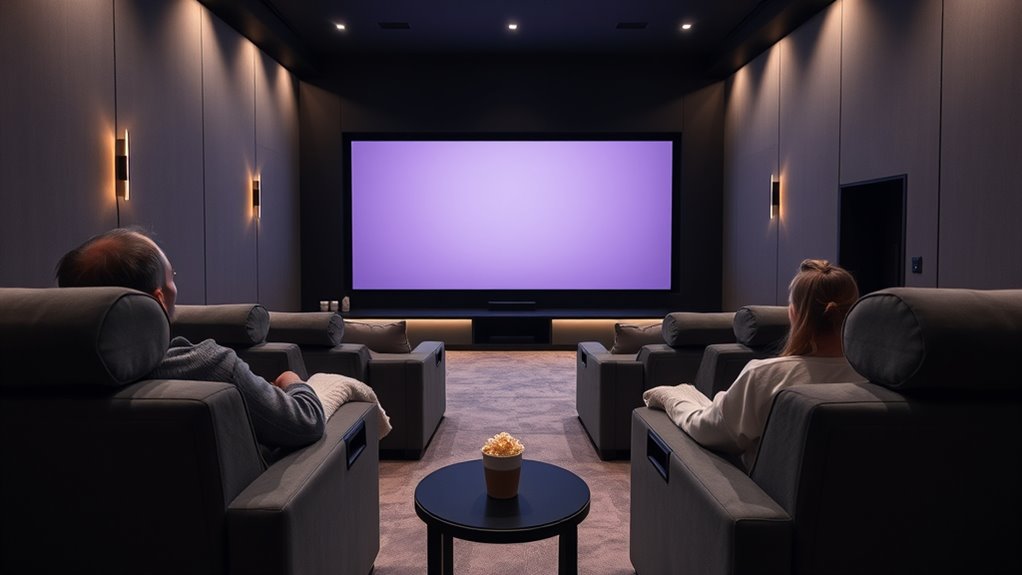
Your comfort and room layout play big roles in choosing the right screen size and seating distance. Think about how you prefer to relax and your space constraints when setting up your viewing area. Tailoring your setup guarantees you enjoy a comfortable and immersive experience. Considering space and organization can help you optimize your environment for both functionality and comfort.
Viewing Comfort Preferences
Have you ever considered how your personal preferences and viewing habits influence the ideal screen size and seating distance? Your comfort depends on factors like color calibration and ambient lighting, which can profoundly impact your viewing experience. To tailor your setup, consider these key points:
- Adjust color calibration to match your environment, reducing eye strain and enhancing image clarity.
- Optimize ambient lighting to minimize glare and reflections, creating a more comfortable viewing space.
- Personalize your seating distance based on your preferred field of view, ensuring you feel immersed without straining your eyes.
- Recognize that relationship dynamics can also affect how comfortable you feel during long viewing sessions, especially when sharing the space with others.
Space and Room Layout
Since personal preferences and viewing habits vary, customizing your space and room layout is essential for an ideal viewing experience. Your furniture placement and lighting considerations directly impact comfort and image clarity. For example, positioning your sofa at the right distance from the screen prevents strain and enhances immersion. Adjusting lighting to reduce glare or reflections ensures better picture quality. Consider this layout:
| Aspect | Tips |
|---|---|
| Furniture Placement | Keep seating at a comfortable distance for clear viewing. |
| Lighting Considerations | Use dimmable lights or blackout curtains to control ambient light. |
| Room Layout | Arrange furniture to minimize reflections and distractions. |
Tailoring these elements to your habits creates a personalized setup that maximizes enjoyment and minimizes discomfort. Additionally, exploring best colognes can enhance your overall experience and confidence during your viewing sessions.
Common Mistakes When Choosing Screen Size and Seating Arrangement
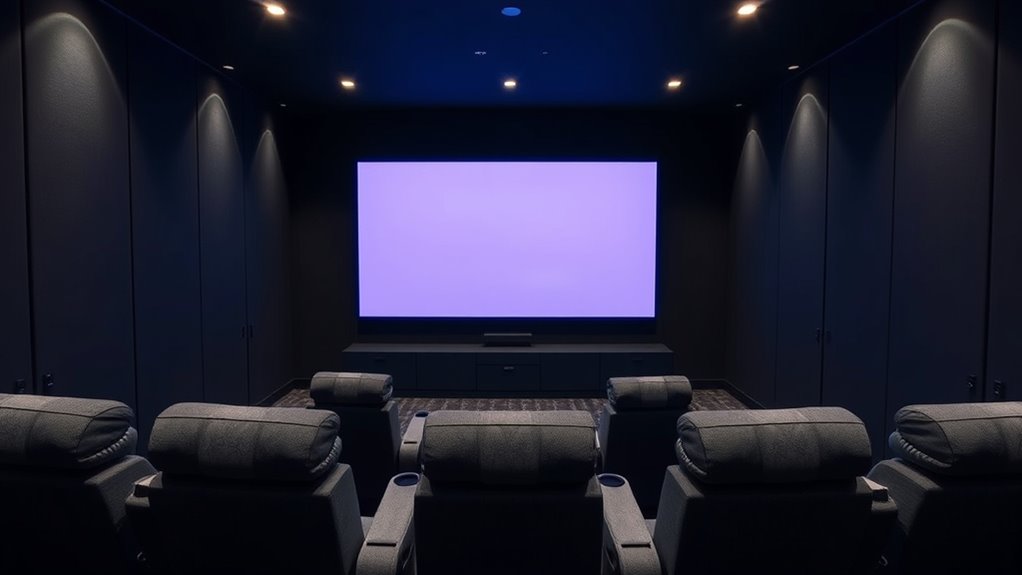
One common mistake is choosing a screen size that’s either too large or too small for your seating distance. This can cause eye strain, discomfort, and a poor viewing experience. To avoid this, consider these key points:
- Ignoring ergonomic chairs that promote good posture can lead to neck and back pain, especially when sitting too close or too far from the screen.
- Overlooking ambient lighting conditions can cause glare or reduce picture clarity, making it harder to enjoy your content.
- Relying solely on generic size recommendations instead of adjusting for your room’s specifics can result in an awkward setup that doesn’t fit your space or seating arrangement.
Getting these factors right guarantees a comfortable, immersive viewing experience without unnecessary strain.
Practical Tips for Optimizing Your Home Entertainment Space
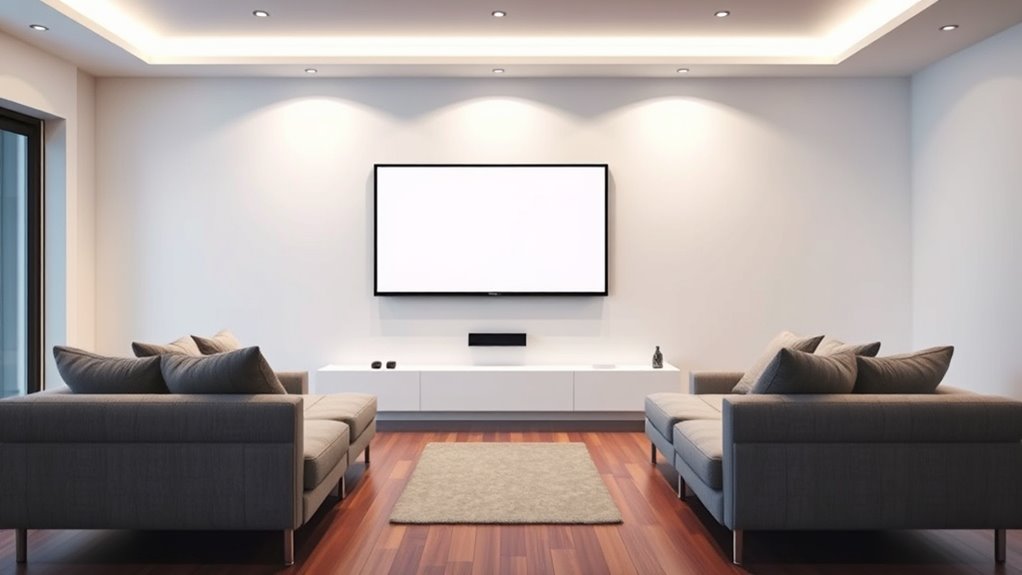
To create an ideal home entertainment space, start by carefully planning your layout to guarantee your seating and screen placement promote comfort and clarity. Choose ergonomic seating that supports good posture during long viewing sessions, making your experience more enjoyable. Position the screen at eye level to reduce neck strain and ensure excellent viewing angles. Incorporate ambient lighting that minimizes glare on the screen and creates a cozy atmosphere without compromising picture quality. Use dimmable lights or indirect lighting options to adjust the mood easily. Keep pathways clear and arrange furniture to promote social interaction and easy access. By focusing on ergonomic seating and ambient lighting, you’ll enhance comfort, reduce fatigue, and create a more immersive entertainment environment.
Frequently Asked Questions
How Does Ambient Lighting Influence Optimal Viewing Distance?
Ambient lighting considerably influences your ideal viewing distance by reducing screen glare and eye strain. When ambient lighting is too bright or uneven, you might need to sit farther away to minimize glare and reflections. Conversely, softer, well-balanced lighting allows you to sit closer comfortably, enhancing picture clarity. Adjusting ambient lighting helps you find the right distance, ensuring a comfortable, glare-free viewing experience without compromising image quality.
What Ergonomic Considerations Should I Keep in Mind for Long Viewing Sessions?
To avoid discomfort during long viewing sessions, prioritize ergonomic posture by sitting upright with your feet flat on the floor and your back supported. Keep your monitor at eye level to prevent neck strain, and maintain a comfortable distance to reduce eye strain. Take regular breaks to stretch, and adjust lighting to minimize glare. These steps help prevent eye strain and promote overall comfort, making extended viewing more sustainable.
Are There Specific Screen Sizes Recommended for Different Room Dimensions?
Is bigger always better? When selecting a screen size, follow screen size guidelines tailored to your room dimensions. For smaller rooms, opt for 40-55 inches to prevent overwhelming the space, while larger rooms can comfortably accommodate 65-85 inches for immersive viewing. Consider room dimension considerations carefully to guarantee your TV fits well, offers ideal viewing angles, and maintains a comfortable distance, creating an inviting entertainment setup without sacrificing comfort.
How Do Different Content Types Affect Ideal Seating Arrangements?
Different content types influence your ideal seating arrangements because your viewing habits and content customization matter. For fast-paced action or sports, sitting closer enhances immersion, while for movies or detailed work, a slightly greater distance reduces eye strain. Adjust your seating based on the content, ensuring comfort and clarity. This approach helps you optimize your viewing experience, balancing immersion with comfort according to what you watch.
Can Adjustable Mounts Improve Viewing Comfort and Flexibility?
Yes, adjustable mounts can considerably improve your viewing comfort and flexibility. With mount flexibility, you can easily adjust your screen’s height, tilt, and swivel, ensuring ideal viewing ergonomics. This helps reduce neck and eye strain, especially during long sessions. By customizing your setup, you create a more comfortable and adaptable environment, making it easier to enjoy your content without discomfort or limitations caused by fixed mounts.
Conclusion
Remember, bigger isn’t always better—you need to find what’s comfortable for you. Consider your viewing angle, distance, and the quality of your screen instead of just size. Personal preferences and habits matter too. Are you sacrificing comfort for the sake of a bigger screen? Ultimately, customizing your setup guarantees a better viewing experience. Focus on what truly makes you enjoy your entertainment, not just what looks impressive.
